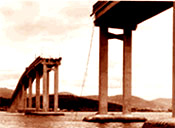|
|
The Remarkable Story of Wallace Bowles

Wallace Bowles, 76, a former Royal Australian Air Force fighter pilot, senior commercial pilot and aircraft accident investigator, had no formal medical training. But this did stop him from becoming an expert on the disease-inducing effect of sitting toilets. Wallace's mastery of the subject was the result of a five-year personal research, when he was in his early 50's, on the link between sitting toilets and colon, bladder, prostate and pelvic ailments that are prevalent in Westernised countries. Following his research, Wallace Bowles has written and published numerous articles and books. His knowledge, passion and strong desire to save people from the health threat posed by sitting toilets are clearly evident in his writings. This page is a tribute to Wallace Bowles, and showcases his work on toilet-related health problems.
| 1. | The Design of The Human Body A study of anatomy shows that humans are designed for defecation primarily by squatting. The colon … has one inlet valve from the small intestine (the ileocecal valve) and one outlet valve (the anal canal). Now, if the colon is to be emptied, the inlet valve has to close and the outlet valve has to open. The indications are that both valves function as they should only when we squat. [Back to Top] | | 2. | The Problem With Sitting Toilets Repeated use of the sitting toilet results in, or aggravates, many common conditions. By sitting, the anal canal is kinked, and has to be opened forcibly by the descending fecal mass, often by straining. Because the anal canal is forced open when we sit for bowel movements, gradual injury – pain-free at first – to the anal and pelvic areas can initiate, or aggravate, numerous bowel and bladder conditions. Elimination in the seated position results in repeated injury, complications of which, ultimately, can kill. [Back to Top] | | 3. | What's So Great About Squatting? The anal canal straightens physiologically only when we squat. When we squat, in response to an urge, the waste just falls out… Almost everyone who changes habit and squats, rather than sits, for defecation experiences benefit. Constipation, haemorrhoids, anal fissures, diverticulitis, irritable bowel syndrome, bowel incontinence, bladder incontinence (including children’s bed-wetting), prolapse, prostate disorder, cystitis and urinary tract infections, Crohn’s Disease, low back and sciatic pain… Anecdotally, all of the above have improved, and have often been completely corrected, after a simple change in daily habit – from sitting to squatting for bowel movements. Such other conditions (that could be improved) could include ulcerative colitis, solitary ulcer syndrome, rectal prolapse, non-infant Hirschprung’s Disease, intussusception, appendicitis, abdominal hernia, impotence, perianal pain, rectocele, colorectal cancer, and prostate cancer. And because squatting for bowel movements results in more complete elimination of toxins, skin problems should be more easily manageable. [Back to Top] | | 4. | Toileting Posture and Pelvic Floor Health Pelvic floor nerves can be protected only by squatting for bowel elimination. Pelvic floor injury is an inevitable consequence of eliminating waste in the seated position… yet one may not be consciously aware of the injury occurring. (Urinary or bladder) incontinence conditions…are due to repeated injury when we evacuate our bowels in the seated position. [Back to Top] | | 5. | The Introduction of Sitting Toilets In The West …Thomas Crapper and his colleagues introduced the flushing, sitting loo after sewer mains were constructed in London. The flushing bit is excellent. Thomas Crapper should be remembered for his contribution to human health, namely, for the significant improvement in hygiene which resulted from using his products. But the sitting bit has been, and is, an on-going disaster of gigantic proportions. How could our near ancestors, who accepted the pedestal loo so readily when it became available to members of our society only about 150 years ago, have been so stupid! Surely someone would have wanted to know what the effects of this radical posture change from squatting to sitting for bowel movements were likely to be in the long term. There were such thinking people, but their voices fell on deaf ears – and we all suffer the consequences. [Back to Top] | | 6. | East and West: A Case of Squatting vs Sitting About 75% of the world’s population squats and is relatively free of the bowel and bladder problems that plague people in the West, who prefer to sit on elevated toilets. [Back to Top] | | 7. | It's Never Too Late To Change... Even though we all should have been squatting for bowel movements throughout life from the toddling age, it is not too late to experience benefit, irrespective of age, providing we are sufficiently flexible to squat. [Back to Top] | | 8. | The Choice That Lay Before Us It is important to begin squatting for defecation and to continue throughout life – on every occasion. It could take you many years to understand the importance of this needed change. But, like most people who drive motor vehicles without understanding their mechanical workings, there is no need for you to understand details of the concept to obtain benefits which, for some, could be beyond their wildest dreams… Your decision to eliminate with a daily squat could prolong your life and, more importantly, will improve your quality of life. [Back to Top]
| | 9. | "Nerve Stretch Injury - A Clarification" by Wallace Bowles Muscles need a nerve supply to function. The pudendal nerve, from sacral vertebrae 2 to 4 (of the spinal cord), supplies muscles of the pelvic floor. Nerve stretch injury to the pudendal nerve of mothers during childbirth is not uncommon. And they often suffer from bladder incontinence as a result. But many women suffer from bladder weakness and incontinence without having delivered a child, so a different mechanism is involved. Men also have a pudendal nerve and one of its functions is to supply nerves in the prostate. What is the common injury involving the pudendal nerve? The common injury mechanism for men and women is the forced opening of the anal canal kink when seated for defecation, leading often to bed-wetting in children, bladder weakness and incontinence in women and prostate disorder in men. When people with bowel incontinence have a bowel movement, their perineums descend to a degree consistent with a nerve stretch of about 20% or 30%. Nerves are "irreversibly injured" when stretched by as little as 12% of their length, so nerve destruction would seem certain for many people from the effects of seated defecation. "Irreversible injury" sounds permanent, but all is not lost. Destroyed nerve fibers downstream from the location of the stretch injury do not re-grow. But by avoiding repetitive injury (ie: continuing to use sitting toilets), nerves can re-grow from the active side of the stretch injury or from adjoining tissue. Muscles become functional again. Many women with bladder incontinence have regained normal control simply by changing posture for defecation from sitting to squatting. When sitting, the perineum is lax, lending itself to nerve stretch injury during evacuation. In contrast, when squatting the muscle cradle forming the pelvic floor is firm, protecting against nerve stretch injury. Squat for defecation and, with a firm pelvic floor and straightened anal canal, pelvic floor nerve stretch is minimal. And some good news? Nerves re-grow at about the same rate irrespective of age. An agile 92 year old woman regained bladder control within 3 months by squatting for defecation. However, squatting is not for the infirm. This example is given to indicate that we are never too old. As long as we remain agile and squat for defecation, pelvic floor injury and inflammation can be minimised. [Back to Top]
| | 10. | A Bridge Accident in Tasmania - by Wallace Bowles
The Tasman Bridge crosses the Derwent River in Hobart, Australia, on the island of Tasmania.
 In 1975 a pylon of the bridge was struck by a freighter, causing one of the spans to collapse. It was drizzling and after dark, so visibility was poor. Bridge traffic kept coming over the rise in the bridge and hurtling 110 feet into the river below.
In 1975 a pylon of the bridge was struck by a freighter, causing one of the spans to collapse. It was drizzling and after dark, so visibility was poor. Bridge traffic kept coming over the rise in the bridge and hurtling 110 feet into the river below. I don't think the final death toll was ever known. But apparently one driver became aware of the collapsed span. He stopped his car and tried to warn others, but most of them took no notice and kept going to their deaths. When I talk to people about squatting, I often feel like that guy. I feel the frustration he must have felt. The response of most people is that they don't want to know about it; many seem to think they are being had by some practical joker, others that it's a sales gimmick, others that the only appropriate opening for anyone stupid enough to promote such an idea is the door into a lunatic asylum. It's only when people see that their lifespan is shortening before their eyes that they become open to the idea and, if it's not too late, it usually works positively for them. [Back to Top] |
Go from Wallace Bowles to Home Page
|
|
|







 In 1975 a pylon of the bridge was struck by a freighter, causing one of the spans to collapse. It was drizzling and after dark, so visibility was poor. Bridge traffic kept coming over the rise in the bridge and hurtling 110 feet into the river below.
In 1975 a pylon of the bridge was struck by a freighter, causing one of the spans to collapse. It was drizzling and after dark, so visibility was poor. Bridge traffic kept coming over the rise in the bridge and hurtling 110 feet into the river below.



